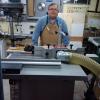
Originally Posted by
Warren Lake

we were brought up on hand feeling and I enjoy it. nice sharp cutters and its as enjoyable as using a hand plane at its best. You have better feedback than a feeder because you feel the cutter cutting and you choose the speed unless you have a feeder where you can dial in any speed you want. It offers several advantages for sure. Unless your set up is right on some cuts its not going to do a far better job than by hand. Ive seen stuff off feeders that didnt match what I can do with old cutters and hand fed.
I'm glad I'm not the only one like this.
There was a shaper in wood shop from the 7th grade, to the 12th grade, and I don't ever remember seeing a power feeder, even though it was a zillion years ago. I'd like to have one, no argument there, but I don't "need" one.
Mark
If you're new to the shaper, here is probably the best tutorial on the internet. Nothing fancy, just basic operation for a home shop guy.
https://www.youtube.com/watch?v=4n6yTHMBX54
"The first thing you need to know, will likely be the last thing you learn." (Unknown)
Anyway all this to say there is a fair amount of work that gets done sans feeder.




 Reply With Quote
Reply With Quote


 ......Rod.
......Rod. . It does sound like a good idea though.
. It does sound like a good idea though.

